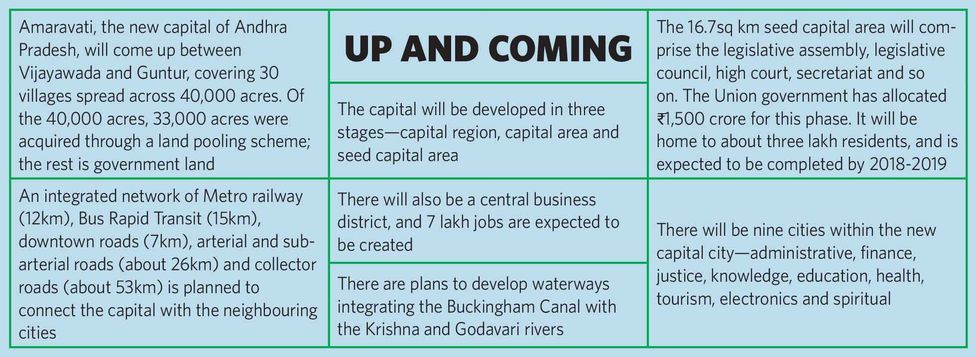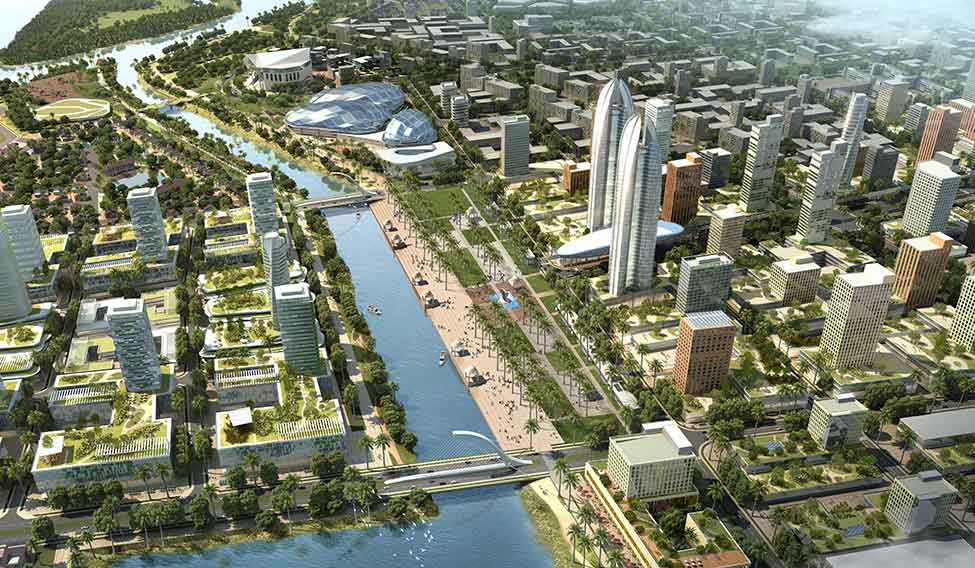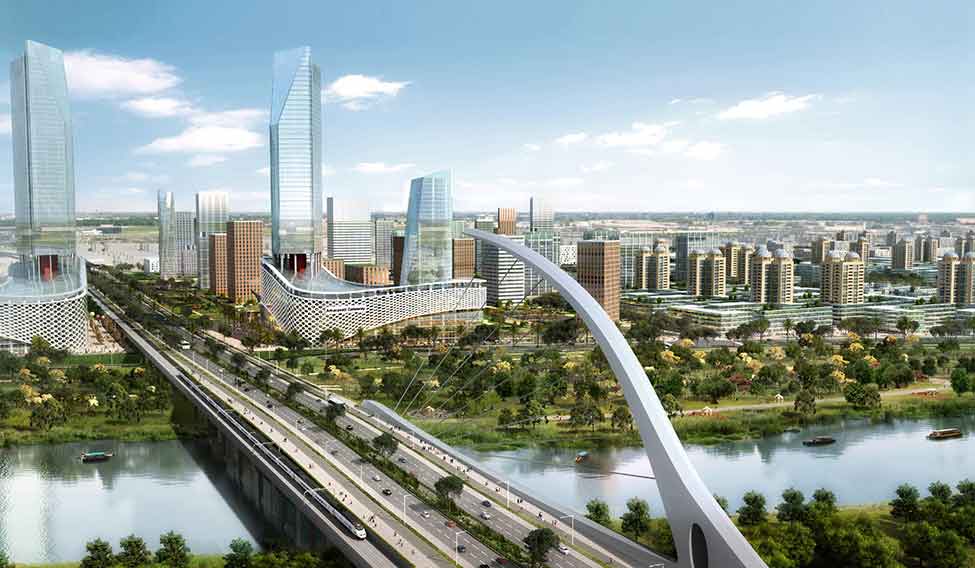Andhra Pradesh Chief Minister Nara Chandrababu Naidu is no civil engineer, but developing cities has become his forte of sorts. First, he transformed Hyderabad, now the capital of Telangana. He still talks fondly of Hyderabad and the initiatives he took to put it on the global technology map, but he is now far more excited about building a capital for Andhra Pradesh. The foundation stone has been laid and a name, Amaravati, has been chosen. The capital city will come up on 30 villages between Vijayawada and Guntur, and will be just 35km away from the old Amaravati town, the capital of the Satavahana empire some 2,000 years ago. “Amaravati is envisaged to be developed as a smart, green and sustainable city,” said Naidu. “Our aspiration is to create a vibrant, diverse, inclusive and modern city, which will be a symbol of pride for the people of Andhra Pradesh and India.”
Amaravati made the cut after due consultations with vaastu experts and historians. It is the only place where the Krishna flows north instead of south or east, and this is considered auspicious. The region is steeped in history—the Satavahanas built their capital at Dharanikota, 2km from Amaravati town, and it soon became the commercial capital as well. Before the rise of the Satavahanas, Amaravati had been a seat of Buddhism; a stupa and a monastery were built during the reign of Emperor Ashoka. The Satavahanas patronised Hinduism, and Amaravati was then known as Amararamam because of the ancient temple of Amaralingeshwara (Lord Shiva). Subsequent dynasties patronised Jainism, and the city came to be called Sridhanyakataka or the ‘City of Tolerance’. Amaravati got its name thanks to an 18th century king—Raja Vasireddy Venkatadri Naidu.
History will now be rewritten as a modern city rises from the past glory of an ancient one. “The location of Amaravati is perfect and the name is a great achievement,” says M. Ravi Krishna, a publisher and teacher. “We are anxious for this new capital to come up because we got the raw end of the deal in the [state] division.”
Not that Amaravati is the only capital being built—Nayaraipur in Chhattisgarh is in the reckoning—but the kind of planning that has gone into the designing of Amaravati will leave behind any city, old or new. The state has started innovative campaigns—Naidu's brainchild largely—like the 'My brick, My Amaravati', where one can donate online for the capital's development, and the mana neeru, mana matti (our water, our soil) campaign, for which Prime Minister Narendra Modi, too, gifted a pot of soil from the Parliament complex and water from the Yamuna when he flew down for the Amaravati foundation ceremony.
Though Naidu will go down in history as the creator and designer of the new city, he definitely had help—right from farmers who gave up their fertile lands, to nations who helped with design and development. The government has procured nearly 33,000 acres through a land-pooling scheme, wherein farmers will be compensated with Rs.50,000 per acre per year for ten years and with residential and commercial spaces once the city is built. There was some opposition to acquiring agricultural land, but Yarlagada Harish Chandra Prasad, chairman of Malaxmi Group, said that the ‘land for capital’ campaign had received undue negative publicity. “Who is protesting the building of the capital, except for the YSR Congress Party?” asked Prasad. “Even the farmers are happy, except for a few who are now regretting [their decision]. There were some who protested vehemently and have now surrendered their land because they realise that it is for their own good.” Prasad is working on a collaborative book, detailing the past, present and future of Amaravati.
Last December, the government signed an MoU with Singapore government agencies to prepare a master plan for Amaravati. Surbana Jurong Private Limited was appointed as the master planner, and the final plan was submitted on July 20, 2015. “After the Telugu Desam Party came to power, the Singapore government, in a gesture of goodwill, offered to make the master plan free of cost and delivered it on time; in fact, a couple of days in advance,” said Parkala Prabhakar, communications adviser in the Andhra government. Singapore also shared its expertise in urban governance with Andhra government officials, and trained more than 20 of its officials.
“The capital city will be built in three phases—capital region, capital area and seed capital area,” said Prabhakar. “This is an ambitious plan and the financial aspect can be broken into two parts. The core administrative city will have to be funded by the government of India, as per the Andhra Pradesh Reorganisation Act.” The other investments will come from funding by private investors, private-public partnership and other methods.
The challenge is to have a master developer—a firm or a consortium of firms —to anchor the project and mobilise investors. The state government will have a 42 per cent stake in the project, which will take concrete shape over a period of time, said Prabhakar. But the “core government infrastructure will be ready by 2018-2019,” he said.
The construction of the seed capital development area—16.7sq km—will commence soon and will comprise the legislative assembly, legislative council, high court, secretariat, Raj Bhavan, quarters for the ministers and bureaucrats, and a township for other government officials. A Singapore consortium comprising Ascendas-Singbridge Group and Sembcorp Development Limited has expressed interest to develop the seed capital area. And, Singapore is preparing to submit a bid for the project, said Singapore Trade and Industry Minister S. Iswaran, who represented Prime Minister Lee Hsien Loong at the foundation stone laying ceremony.
The government is also in talks with Japan, Israel and China, seeking help in capital development. An MoU was signed with the Japan Bank for International Cooperation to develop the capital area and region. As part of a memorandum of cooperation, an Andhra Pradesh Investment Task Force will be set up in Japan for promoting Japanese investments in the state.

“We need a level playing field with neighbouring states such as Karnataka and Tamil Nadu, and to have a suitable capital. That is why we are asking for a special status with a package,” said Prabhakar. But there was no special status announcement by Modi, nor was there any financial package similar to the Bihar one. Modi merely said that the Centre would keep up all its promises as per the Act.
But this has not dented the morale of the Capital Region Development Authority, and work on the capital region plan, covering 7,325 sq km, will soon start. The master plan identifies the long-term economic positioning of existing towns and cities within the capital region and the context, therefore, for the growth and development of the future capital city. According to Singapore officials, it includes a regional socioeconomic analysis and a demographic study, and recommends a set of strategies to enhance connectivity to neighbouring cities and towns while protecting agricultural zones and heritage areas.

But there are certain fears about the upcoming city, one of them being flooding, as Amaravati is to be a riverfront city. But Prasad dismissed the fears. “The mean sea level for the Krishna river is 22m, and most of the land is above it,” he said. “I studied the material with the irrigation department. The floods have never been because of the Krishna but because of the Kondaveeti Vagu [stream]. But as per the plan, they are going to build a reservoir and this will look like a lake once built, and the danger, if any, will be averted. And there are plans to build one more reservoir on the Pulichintala. So, here it will be a pure reservoir, a controlled lake, if you want.”
A study conducted by Andhra University, the Indian Institute of Remote Sensing and the K.L. University said Amaravati could face a severe shortage of potable water, with the groundwater being highly polluted.
This, the study said, is because of indiscriminate use of chemical fertilisers and pesticides over decades on horticultural and agricultural crops, which has turned the groundwater either saline or alkaline.
There is another fear that what was once verdant land will turn into a concrete jungle. But Prasad said: “When Vijayawada was being developed on 60sq km, [the ratio of] the built-up area to free space was 70:30. Amaravati is to be built on 212sq km and as per the Singapore master plan, which will be followed religiously, the built-up area to free space is 50:50.” So of the 40,000 acres of land—33,000 acquired via land pooling from farmers and almost 7,000 acres belonging to the government—only 20,000 will be built-up area. Of this, as part of the land pooling scheme, 15 per cent would go back to the farmers.
The government is also planning to give close to 1,500 acres for the expansion of the Vijayawada airport. And if the government is to follow the master plan, 2,000 acres will go to the developer. The government needs money only to build houses for 60,000 of its employees, said Prasad. Also, there are rumours that more than 10,000 acres have been bought by the rich and the famous from Hyderabad.
“The chief minister wants an active capital, unlike Putrajaya or Brasilia, where the city is dead after office hours and on holidays,” said Prasad. “So, there will be a lot of interface between the citizen and the building of the capital.”








